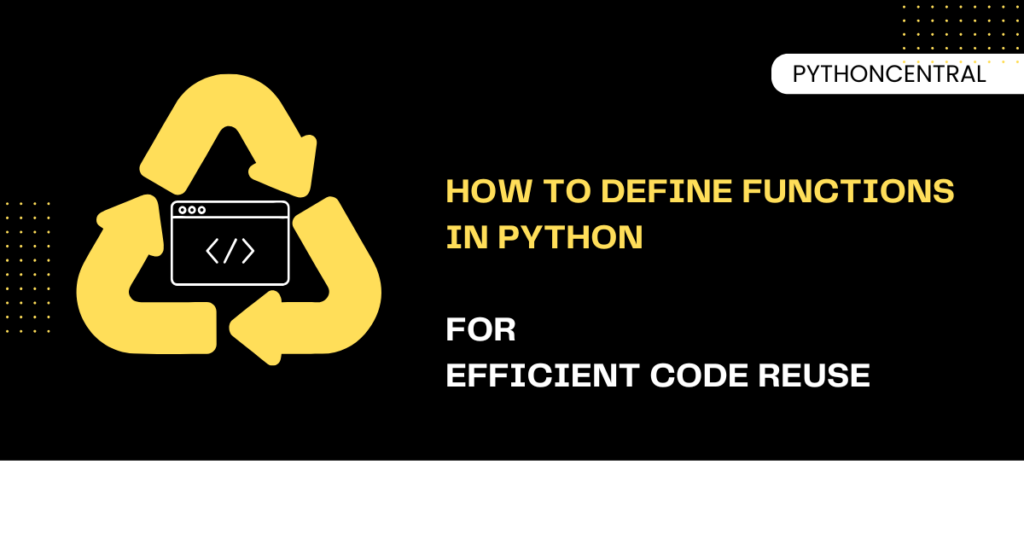When you get more familiar with programming, you will feel the need for "code reuse". Functions make code reuse easy. To understand functions, let us take an example. If your friend needs the instructions to come to your house, either you can give them a step-by-step instruction list, or make it easier by referencing landmarks. When you say, "after reaching landmark XYZ", you are indirectly clubbing a lot of instructions in a single sentence. Functions are very much similar to that. And this is exactly why in Python, define functions is important.
In Python, defining functions is easy and also a foundational skill that can improve your code’s readability, modularity, and efficiency. Whether you are just starting your Python journey or building scalable applications, learning how to define functions in Python is essential. Get. Set. Let's learn!
What Is a Function in Python?
We already looked at an example. Let us learn what a function in Python is technically. A function is a block of reusable code that performs a specific task. Instead of repeating code, you define it once in a function and call it whenever needed. This helps in writing cleaner and more maintainable programs.
Basic Syntax: How to Define a Function in Python
The basic syntax for defining a function is:
def function_name(parameters): """Optional docstring""" # Function body return result
Let us look at an example now.
def greet(name):
"""Return a greeting message."""
return f"Hello, {name}!"
Some key points to remember are:
- Use the "def" keyword.
- Followed by the function name and parentheses.
- Add any parameters inside the parentheses.
- Indent the function body.
- Optionally use "return" to send a result back.
How to Call a Function in Python
Once you have defined a function, you can call it (reference it) by using its name followed by parentheses. Here is an example script to understand better:
message = greet("PythonCentral")
print(message)
# The output will be: Hello, PythonCentral!
Python Function Parameters and Arguments
Now let us learn some basic Python function parameter and arguments.
Positional Arguments
Positional arguments are those that are passed in the same order as defined. Here is an example for a script that uses positional arguments:
def add(a, b): return a + b print(add(5, 3)) # Output will be: 8
Keyword Arguments
Keyword arguments pass by name. Let us look at an example for the same:
print(add(a=10, b=20)) # 30
Default Arguments
Let us learn how to assign a default value to parameters with an example:
def power(base, exponent=2): return base ** exponent print(power(3)) # 9 print(power(3, 3)) # 27
Variable-Length Arguments
Here is an example that uses args and kwargs for dynamic input.
def print_numbers(*args): for num in args: print(num) print_numbers(1, 2, 3, 4)
Now this script uses kwargs:
def show_info(**kwargs):
for key, value in kwargs.items():
print(f"{key}: {value}")
show_info(name="PythonCentral", age=30)
Return Values in Python Functions
Use the "return" keyword to return values. Here is how you can do that:
def multiply(a, b): return a * b result = multiply(4, 5) # This script returns an output 20
You can return multiple values using tuples:
def get_stats(numbers): return min(numbers), max(numbers) low, high = get_stats([3, 7, 2, 9])
Lambda Functions (Anonymous Functions)
Python also allows you to define small, one-line functions using the "lambda" (probably what inspired AWS' Lambda services) keyword:
square = lambda x: x * x print(square(5)) # 25
Use lambda functions when you need a short, unnamed function. They are often "map()", "filter()", or "sorted()". Now that we think about it, we will cover lambda functions as well in a detailed tutorial.
Best Practices for Defining Functions in Python
Here are some best practices to be kept in mind when you are defining functions:
- Each function should do one thing well. Keep functions small and practical.
- The name should describe the function’s purpose. Do not name your functions as "Dave" or "thirdfunction".
- Document what the function does and what parameters it expects.
- Functions should return results without changing external state unless necessary.
Here is an example with type hints:
def divide(a: float, b: float) -> float:
if b == 0:
raise ValueError("Cannot divide by zero")
return a / b
Common Errors When Defining Functions
Here are some common errors you may face in your initial days of working with Python define functions.
- Missing ":" after the function header
- Forgetting "return" causes no result to be returned
- Overwriting built-in names causes bugs. Do not overwrite names like sum or list.
Wrapping Up
Learning how in Python define functions is a crucial step toward writing efficient and maintainable code. From simple greeting functions to advanced argument handling with args and kwargs, functions help you to organize and reuse logic effectively.
Whether you're building web apps, crunching data, or automating tasks, a solid understanding of Python functions will enhance your programming skills.

